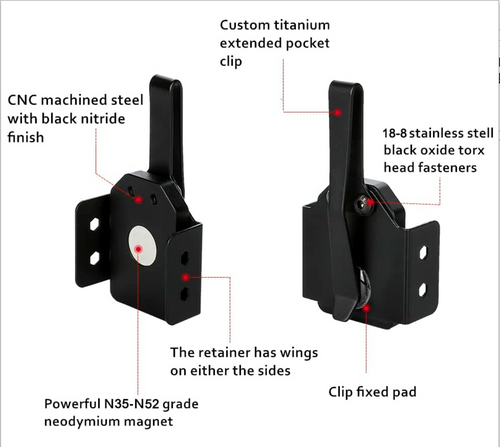Choosing the right holster - Inside-the-Waistband (IWB) or Outside-the-Waistband (OWB) - depends on your priorities: concealment, comfort, or quick access. Here’s a quick breakdown:
- IWB Holsters: Worn inside your pants, offering excellent concealment and discretion. Best for smaller firearms and formal or professional settings. Downsides include less comfort, especially during long wear, and slower draw speed.
- OWB Holsters: Worn outside your pants, prioritizing comfort and fast access. Ideal for larger firearms, outdoor activities, or extended wear. However, concealment is harder, requiring specific clothing choices.
Quick Comparison
| Feature | IWB Holsters | OWB Holsters |
|---|---|---|
| Placement | Inside waistband | Outside waistband |
| Concealment | High | Moderate |
| Draw Speed | Moderate | Fast |
| Comfort | Limited with larger guns | Excellent for all sizes |
| Clothing Needs | Minimal adjustments | Requires cover garments |
Bottom line: If concealment is your top priority, IWB is the way to go. For comfort and accessibility, especially with larger firearms, OWB is a better choice. Match your holster to your lifestyle, firearm size, and daily activities for the best fit.
IWB vs OWB - The basics about holsters and concealed carry
IWB and OWB Holster Basics
Getting a good grasp of IWB and OWB holsters can help you decide which carry style fits your needs.
How IWB Holsters Work
IWB (Inside-the-Waistband) holsters are worn inside your pants, secured with clips or loops. This design keeps your firearm close to your body, making it easier to conceal. Many modern IWB holsters also feature a tuckable option for added discretion.
"When you opt for an IWB holster, you're choosing a method that keeps your firearm tucked away, minimizing visibility." – Scott W. Wagner
This style works best for small to medium-sized handguns due to its snug positioning.
How OWB Holsters Work
OWB (Outside-the-Waistband) holsters prioritize fast access over concealment. They attach to your belt using loops or paddle attachments, providing a stable and accessible option for carrying. The external placement allows for a natural and quick draw, making OWB holsters ideal for larger handguns or long carry periods.
"Choosing an OWB holster emphasizes a quick and easy draw, as the firearm is positioned outside your pants for rapid accessibility." – Scott W. Wagner
Here’s a quick comparison of the two styles:
| Feature | IWB Holsters | OWB Holsters |
|---|---|---|
| Placement | Inside waistband | Outside waistband |
| Securement | Clips or loops | Belt loops or paddle |
| Concealment Level | High | Moderate |
| Draw Speed | Moderate | Fast |
| Comfort with Large Firearms | Limited | Excellent |
Up next, we'll delve into the pros and cons of each holster style.
Comparing IWB vs OWB Features
IWB Strengths and Limits
Inside-the-waistband (IWB) holsters are great for concealed carry, especially for those who want to keep things discreet. Their close-to-the-body fit helps reduce printing, making them a solid choice when paired with loose-fitting clothes.
Many IWB holsters come in tuckable designs, which allow you to wear them with a wider range of outfits. However, this added concealment can sometimes come at the cost of slower draw speeds and reduced comfort.
Some challenges with IWB holsters include:
- Less comfort over long periods, particularly with larger firearms
- Slower draw speed due to the need to move clothing out of the way
- Requires more practice to achieve a consistent and smooth draw
Now, let’s look at how OWB holsters stack up when it comes to comfort and accessibility.
OWB Strengths and Limits
Outside-the-waistband (OWB) holsters are all about comfort and ease of access. Since they sit externally, they allow for a more natural and faster draw, which can be a big advantage.
"Regardless of how big the gun is, OWB always feels more comfortable and that's a big factor in guaranteeing you'll carry your gun day in, and day out." - Travis Pike
OWB holsters are especially comfortable in situations like:
- Long periods of sitting or driving
- All-day carry
- Using larger firearms
- Activities that involve frequent movement
Here’s a side-by-side look at how IWB and OWB holsters compare:
| Feature | IWB Performance | OWB Performance |
|---|---|---|
| Concealment | Excellent | Moderate |
| Draw Speed | Decent | Outstanding |
| All-Day Comfort | Best with smaller firearms | Great for all firearm sizes |
| Clothing Requirements | Minimal adjustments | May need specific cover wear |
| Physical Activity Fit | Works well with positioning | Excellent with secure fit |
While OWB holsters excel in comfort and quick access, they fall short in concealment. Since they sit outside the waistband, you’ll need to carefully choose your clothing to maintain discretion. Balancing these factors is key when deciding which holster style suits your needs.
sbb-itb-7fb5bb8
How to Pick Between IWB and OWB
Hiding vs Quick Access
Deciding between concealment and draw speed often determines which holster type suits your needs. IWB holsters are great for keeping your firearm out of sight, making them a solid choice for everyday carry in public.
On the other hand, OWB holsters focus on quick access and ease of movement. As Scott W. Wagner puts it, "OWB holsters are often favored by those who prioritize a rapid and unrestricted draw, such as competitive shooters."
Here’s how different situations might influence your choice:
| Scenario | Better Option | Key Benefit |
|---|---|---|
| Business Attire | IWB | Keeps your firearm hidden with ease |
| Competitive Shooting | OWB | Allows faster draw times |
| Public Spaces | IWB | Reduces the chance of printing |
| Outdoor Settings | OWB | Offers comfort and accessibility |
Now, let’s look at how these holsters stack up for long-term comfort.
All-Day Comfort
Your routine plays a big role in how comfortable each holster style feels. OWB holsters often win out for extended wear, especially with larger firearms, because they sit outside the waistband and don’t press directly against your body.
If you’re sitting for long periods or driving, OWB holsters can feel much better. Tight pants can make IWB holsters less comfortable, particularly with compact or subcompact guns.
Key comfort considerations:
- Less skin contact: OWB holsters reduce direct pressure on your body.
- Better weight distribution: OWB holsters spread the gun’s weight more evenly across your belt.
These factors can make a big difference depending on your daily activities.
Daily Activities Impact
Patrol Sergeant Scott W. Wagner explains, "OWB is the only type of carry to be considered when packing a handgun on the trail or for extended 'walkaround' carry."
For office environments where discretion is a must, IWB holsters provide the concealment you need while maintaining a professional appearance. But if you’re outdoors or in settings where hiding your firearm isn’t as crucial, OWB holsters offer better comfort and access.
Your activity level also matters:
- Extended walking: OWB holsters distribute weight more effectively.
- Frequent sitting: OWB holsters reduce pressure points.
- Professional settings: IWB holsters keep your firearm out of sight.
Ultimately, your environment, routine, and priorities should guide your choice. As Wagner notes, it all comes down to what works best for your lifestyle.
Real-Life Usage Tips
When choosing a holster, factors like body shape, clothing choices, and the size of your firearm play a big role in finding the right fit for comfort and concealment.
Body Shape and Clothes
Body types vary widely, which means there’s no one-size-fits-all solution. As Scott W. Wagner puts it, "Not everyone has an average body shape. Some people are skinny and some are bigger than average. No matter what body type you have, you can still conceal carry and be comfortable."
Here are some general recommendations based on body type:
| Body Type | Holster Style | Suggested Carry Position |
|---|---|---|
| Slim/Athletic | IWB | Appendix carry |
| Average Build | IWB or OWB | Multiple positions |
| Larger Frame | IWB or OWB | Appendix or 2-3 o'clock |
For IWB carry, wearing looser pants can improve comfort. Dark-colored clothing can also help reduce visibility of the firearm's outline.
Gun Size Guide
The size of your firearm is just as important as your body type when selecting a holster. For example, full-sized handguns can become uncomfortable in IWB holsters.
Here’s a quick guide to pairing handgun size with holster style:
| Handgun Size | Holster Style | Key Advantage |
|---|---|---|
| Subcompact | IWB | Easier to conceal |
| Compact | IWB or OWB | Offers more flexibility |
| Full-size | OWB | Distributes weight better |
"Because an OWB holster doesn't place the gun inside the trousers - and in close contact with the skin - a much larger handgun can be carried more comfortably, although more care will be needed in selecting a covering garment." - Scott W. Wagner
Conclusion
After examining the pros and cons of IWB and OWB holsters, it’s clear that the right choice depends on your personal carry needs. Each type has strengths suited to different scenarios.
IWB holsters are great for concealment and are ideal for discreet everyday carry. However, they might require adjustments to your clothing and extra practice with larger firearms. On the other hand, OWB holsters provide better comfort and faster draw times, making them a solid option for larger handguns and extended wear - though they do require careful clothing choices to maintain discretion.
"Your holster is not just an accessory. It's a crucial part of your self-defense strategy. Consider your needs, weigh the pros and cons, and most importantly, practice with your chosen holster to ensure a seamless and safe draw in any situation." - Scott W. Wagner
The bottom line? Choose a holster that fits your lifestyle and priorities. Balancing comfort and functionality will help you stay prepared and confident every day.




